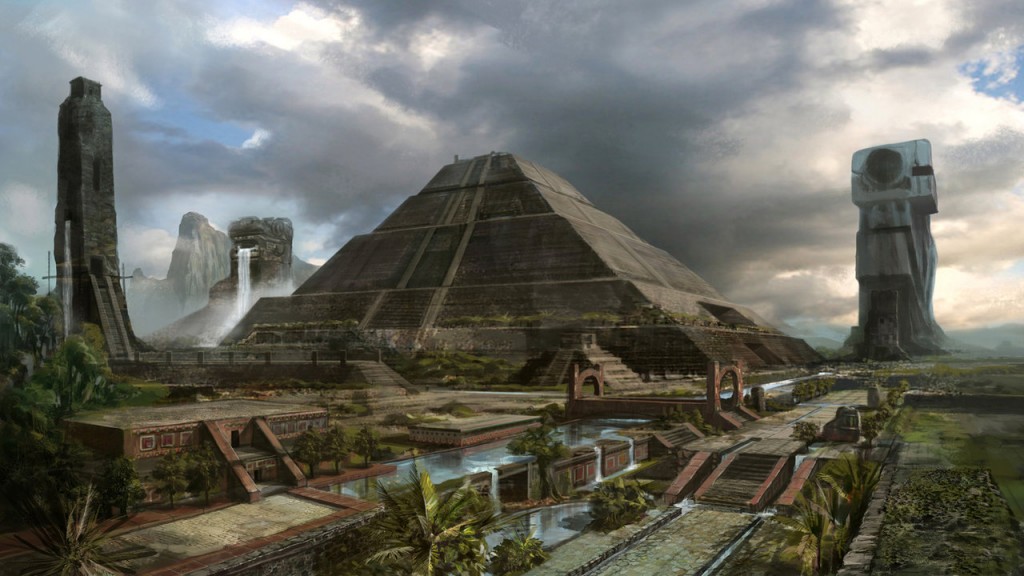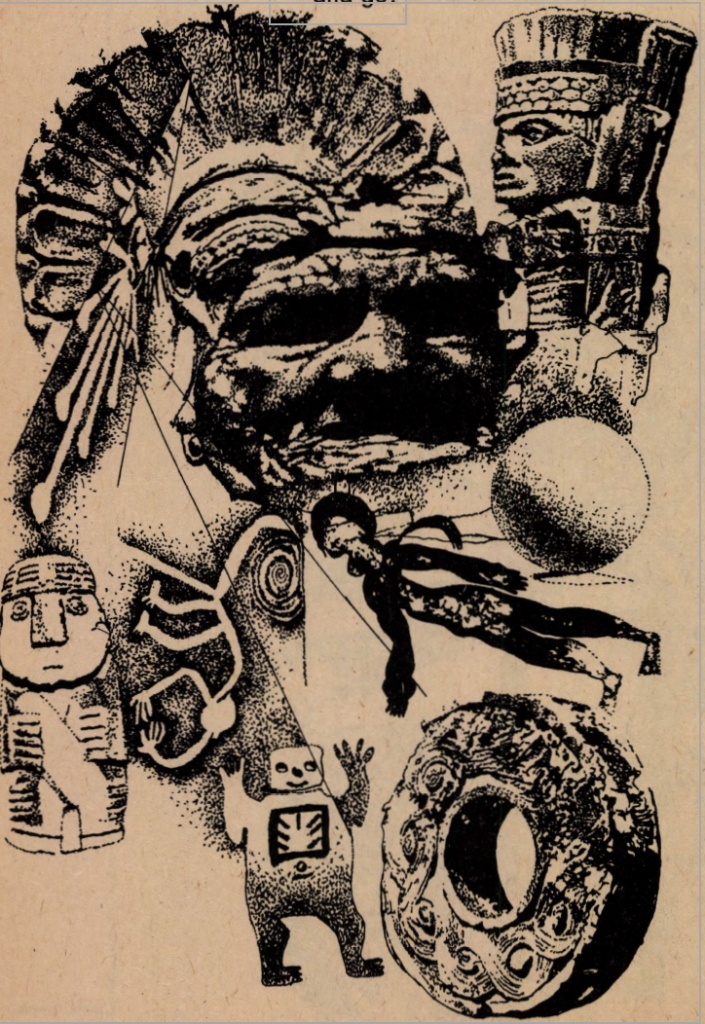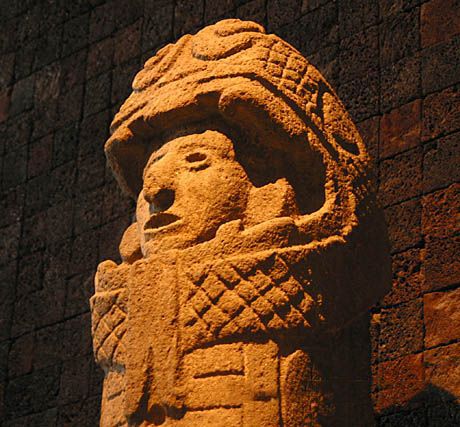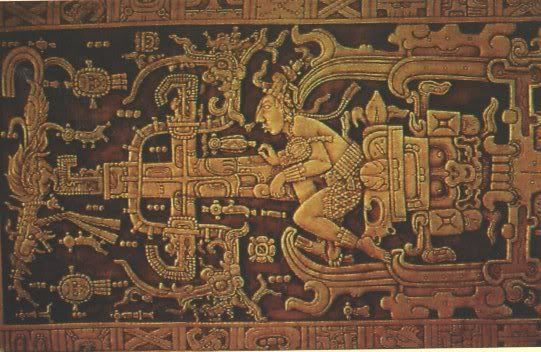
The Mysterious Mayan UFO Connection
- August 18, 2016
- 1
by Eric and Craig Umland
Source: SAGA UFO Report Summer 1974
 Ignorance is best. We have been taught to believe that the Amerinds (American Indians) never caught on to the principle of the wheel. In particular, we are assured in nearly every text on the Aztec, Inca, and Maya, that although these peoples had “civilizations,” they never invented the wheel.
Ignorance is best. We have been taught to believe that the Amerinds (American Indians) never caught on to the principle of the wheel. In particular, we are assured in nearly every text on the Aztec, Inca, and Maya, that although these peoples had “civilizations,” they never invented the wheel.
Anthropologists have known for years, however, that the Maya were well acquainted with the principle of the wheel. Their calendar was circular; they made countless representations of the wheel; their children played with wheeled toys.
Why then are we told otherwise?
Simply, the fact that the Maya were well aware of the use of the wheel and yet never bothered to utilize it brings up new questions that our experts would just as soon not have to consider.
Why didn’t the Maya use the wheel for transportation?
Did they have something better than wheeled vehicles?
Why did they look down on the wheel with contempt, as something fit only for children’s toys?
Add to this “neglect” of the wheel the complete lack of Mayan roads! How did these mysterious people travel back and forth from the Pacific coast of Guatemala to the northern tip of Yucatan?
How did they manage to transport huge stone heads weighing 20 tons or more through miles of impenetrable jungle, without wheeled vehicles and good roads?
How did they transport the giant stones for their temples and pyramids when modern research has shown that there was “no stone in the area itself”?
 All other ancient civilizations as well as all modern-found it absolutely necessary to have good communications between the various outposts of their empires. Consider the long stone avenues of the Inca, the “Royal Roads” of the Persians ·and Assyrians, the great highways of Imperial Rome (when all roads led to Rome).
All other ancient civilizations as well as all modern-found it absolutely necessary to have good communications between the various outposts of their empires. Consider the long stone avenues of the Inca, the “Royal Roads” of the Persians ·and Assyrians, the great highways of Imperial Rome (when all roads led to Rome).
How could the Maya manage to keep their empire intact for so many centuries without any visible means of communication between the more than 120 Mayan cities discovered thus far?
How could a people maintain an empire in the savage jungle for centuries without roads, vehicles, or weapons?
Even in the 2oth Century, the wheel is far from seeming as obsolete to us as it did to the Maya-in spite of our jets and rockets, and in spite of our new knowledge of atomic energy. But if the Maya had no wheeled vehicles, what type of transportation did they use?
Obviously, none of these questions can be answered as long as the Maya is seen through the traditional viewpoint. The traditionalist views the Maya through a tiny pinhole; he allows no knowledge, no fact, to enlarge that pinhole. He fears more light. He is annoyed when asked the q1,1estions we have Just asked. All sorts of evidence, all sorts of facts, can be shown which would give him a new and wider view of the Maya. But the traditionalist feels quite secure. These new revelations are not for him.
Airstrips in Peru. In his book, Mysterious Visitors: The UFO Story, Brinsley LePoer Trench tells us to take a map and draw a line from Lake Titicaca to Caracas. Now draw another from Caracas to Cuzco. The area between these two lined segments is a “little explored” part of South America, ”full of countless terraces and enchanting valleys.” In this same area, Mr. Trench asserts, “numerous landings (of UFOs) have occurred.” Incidentally, near Lake Titicaca is the mysterious Gate of the Sun, a remarkable monument built with
 Incidentally, near Lake Titicaca is the mysterious Gate of the Sun, a remarkable monument built with 200-ton stones 12,000 feet above sea level. The calendar engraved on its facade has been analyzed by the Russian scientist Kazantzev, who concluded that it was “not of this earth, but Venusian.” Erich von
Incidentally, near Lake Titicaca is the mysterious Gate of the Sun, a remarkable monument built with 200-ton stones 12,000 feet above sea level. The calendar engraved on its facade has been analyzed by the Russian scientist Kazantzev, who concluded that it was “not of this earth, but Venusian.” Erich von
Erich von Daniken, in his books Chariots of the Gods? and Gods from Outer Space, describes the puzzling plain of Nazca in Peru. This entire plain is marked with “gigantic lines, laid out geometrically, some of which run parallel to each other, while others Intersect or• are surrounded by large trapezoidal areas.”
These lines seemed meaningless to explorers in the 18th and 19th Centuries, but with the advent of the airplane, the situation changed. Mr. von Daniken reports that: “Seen from the air, the clear-cut impression that the 37-mile-long plain of Nazca made on me was that of an airfield!”
And Robert Charroux assures us that these markings are called “runways” by modern observers “simply because that Is what immediately comes to mind when one sees the great rectangles or trapezoids hundreds of yards to several miles in length.”
Obviously, the Spanish conquistadors arriving in the early 16th Century could hardly be expected to recognize airstrips and landing fields. Even in the first few decades of the 20th Century, man-made airstrips were few and far between. Only now, with our giant airports of the jet age can we recognize the plain of Nazca for what it is (or was).
Interesting coincidence? Is it just a coincidence that, In an area where numerous landings of UFOs occur we find an extraordinary field of lines, geometrical figures and designs which impress all who view them with their likeness to modern-day airstrips? Add to these “interesting coincidences” the questions raised about the Maya and their unknown methods of transportation.
Clearly, what we have found in Peru is another piece of the,same puzzle: Mayan airstrips and landing fields. Consider: people with airstrips and some type of
Consider: people with airstrips and some type of shuttle-craft would certainly have no need for wheeled vehicles and roads. Rather than having to transport supplies through the dense rainforest, the Maya simply flew over it. They needed no system of roads to maintain communications with various parts of their empire . . . only airstrips, and their own aircraft. In England and in the U.S. evidence of such airfields has been found. Can we hope to find more? Quite possibly. Many airstrips and landing fields may still be hidden from the inquisitive eye of the modern researcher by the often impenetrable Central American rain forest: Here,even aerial photography cannot help us. Such airfields would be meaningless marks if seen from the ground, and invisible from the air but it is certain they are there. In Europe, much of Asia, and in the U.S., such markings would have been destroyed by cultivation years ago. In these areas we must assume that no more will be found.
Some may question: Granted, these markings are airstrips and landing fields. But aren’t they too far from Mayan pyramids and temples? Shouldn’t we find them closer to the remains of the Mayan cities? Why would the Maya build their airfields so far from their large urban centers?
Those who ask questions apparently have not driven from our modern airports into the nearest city! Our own rocket launching sites, whose missiles are far inferior to anything the Maya used or are using, are located far from any urban center.

These airstrips are the most concrete pieces of evidence we possess in reconstructing the Mayan transportation system, but they tell us little about the craft which used them. It is obvious that they were used by aircraft, and the questions which now need to be answered are:
When did the last ship leave … or arrive? And are these landing fields still in use?
UFOs in Central America. As mentioned previously, there have been numerous reports of UFO sightings from Central and South America. In fact, Mr. Trench states that “in recent years there has been a tremendous amount of UFO activity over South America, especially Argentina.”
But surely we could be expected to find UFO bases if indeed there are landing fields in the area? Not necessarily. Indeed, it has been theorized that there are UFO landing bases in the ocean off the coast of Peru.
The idea of living beneath the ocean is certainly not fantastic. it is well known that our government has made numerous experiments ‘along these lines . . . and there has been talk of establishing underwater cities at some future date to help .absorb our growing population.
In 1969, four men spent 60 days in underwater experiments to test the possibility of living and working on the continental shelf. They lived in a 160-ton capsule 42 feet below the ocean off St. John, in the Virgin Islands. The name of their project was Tektite.
If continued use of bases on the land could lead to their discovery, it seems obvious that the Maya would have to move their bases off the land and under the water. With their advanced technology and equipment, they could easily live underwater, as our four scientists proved in their experiments.
One of the best-known mysteries of this’ area is, of course, the infamous “Devil’s Triangle,” where hundreds of ships and planes have vanished without a trace. The area has been described as the “point of no return.” There is no doubt about the authenticity of these disappearances. The U.S. Navy was certainly not imagining things when they reported the loss of five planes and the rescue bomber which was sent out to search for them. It is not within the scope of this work to document each and every disappearance within the “Devil’s Triangle.” Suffice it to say that our government notes such disappearances as “Cause: Unknown.” There is no known scientific explanation tor them. Is it that those ships and planes saw something beneath the waves of the “Triangle” that they were not meant to see … that they learned what they were not meant to know?
Only in a few of the cases have messages been received from the missing vessels, and these messages always seem to be “nonsense”! The pilots mention “white water” or complete loss of direction only a few miles from shore. During this period the compass needle spins without cease and navigators cannot distinguish up from down. Did these poor unfortunate people· encounter a type of forcefield which also frustrated the efforts of scientists to X-ray the Great Pyramid and more recently was experienced by explorers in secret Mayan Caves.
Whatever their fate, their disappearance was complete: not even an oil slick remained of the six Navy planes.
Is there a connection between ancient Mayan airbases and these modern mysteries? Can we still believe it coincidence that the most numerous sightings of these UFOs come from Central America and Peru the same areas which contain the airstrips and the same areas which are linked with the mysterious disappearances of so many ships and planes?
When we find forgotten landing fields and airways associated with a civilization which managed such incredible feats of transportation without roads or wheeled vehicles, can we continue to close our eyes to the inevitable conclusion? Can we turn our backs on the truth-discomforting though it may be?
Anything But UFOs. The myth of the flying saucer has been with man from the beginning of his history. Numerous attempts have been made to explain· away their ‘existence. Are they weather balloons, German secret weapons, Russian or American spy craft, ionized gasses in the upper atmosphere, optical illusions, meteorites, hoaxes or are they really something not of this Earth? The list of proposed “reasonable” explanations is almost endless, and still the mystery persists.
Many of these proposed “reasonable” or “scientific” explanations simply cannot stand up to close scrutiny. The U.S. Air Force had so many reports of flying saucers coming in that they had to set up a special project, Blue Book, to handle them. Blue Book was supposed to be a truly thorough inquiry into the numerous UFO sightings.
However, the head of Blue Book, the late Capt. Edward J, Ruppelt, had his doubts about the objectivity of the investigation. In his book, The Report on Unidentified Flying Objects, he stated that at times he suspected that Project Blue Book was just a “front,” a decoy to occupy the public’s attention while some other “real” investigation of UFOs was kept secret.
In other words, our government is well aware of the existence of Maya spacecraft (their shuttle bases) but it fears what such knowledge made public might do, and at the same time it is trying to learn as much as it can about these mysterious people and their civilization from their writings. After all, if a radio program in 1938 could throw the world into a panic, how might the people react to the knowledge that Earth not only has been used as a base for UFOs, but is presently being used as one and that a people foreign to our whole solar system are the unwilling guests of our planet?
Would a general and widespread panic ensue? We think not. We agree with Mr. Trench. that an informed public is a prepared public. Our government … and the other major world powers … seem to believe just the opposite, that keeping the public in ignorance is the best policy.
Flying Saucers in Antiquity. One of the strongest single arguments against the dismissal of UFO sightings as being simply lost weather balloons or faked photos is that we find records of such sightings and reports of UFOs going back thousariqs of years . . . long before such “reasonable” explanations were available.
What were the impressions of ancient civilizations to flying saucers?
All the ancient civilizations tell stories of visitors in flying saucers (fiery chariots, ships without sails which never touched the waves, etc.). The crews of these ships brought the young civilizations of Earth advanced wisdom, writing, and technology-and their good will.
In the Dead Sea scrolls, for example, we find mention of great “fiery chariots” … “a chariot which had wheels of fire.” In the ancient Indian epic, the Mahabharata, there is talk of a “magnificent chariot” which “rose up to a mountain of cloud with a tremendous din.” Beings also flew “on an enormous ray whi.ch was as brilliant as the sun and made a noise like the ·thunder of a storm.” No wonder the Mayan airstrips were so far removed from their residential areas.
Dr. Carl Sagan, of Cornell University and the Smithsonian Astrophysical Observatory, and Dr. I. S. Shlovsky, of the Sternberg Astronomical Institute, Soviet Academy of Sciences, discuss several of these ancient myths in their book, Intelligent Life in the Universe.
Dr. Sagan points out that the Sumerian civilization is generally accepted as one of the first civilizations on Earth of which we have any record, and that the Sumerians gave credit “for their knowledge to extraterrestrial beings.
The Sumerian tradition mentions a strange creature, Oannes, who brought this great knowledge as a gift. According to Alexander Polyhistor:
This being, in the daytime used to converse with men, but took no food at that season; and he gave them an insight into letters, and sciences, and every kind of art. He taught them to construct houses, to found temples, to compile laws’, and explained to them the principles of geometrical knowledge.
We must remember that similarities between Sumerian writing and that of the Maya have already been detected.
Such references to extraterrestrial beings and vehicles can also be found in the Bible, and in the traditions and legends of the Babylonians, Hindus, Chinese, Polynesians, Japanese, Tibetans: Egyptians, Minoans, Greeks, Africans, Eskimos, and among the Arabs (who have worshipped a gigantic black meteorite preserved in a temple in Mecca-the Kaaba -since time immemorial).
One of the most inspired of the ancient peoples, the Celts, who sacked Rome and established, a culture stretching from India to Great Britain, tell us that their “father,” the Magician-King Bran, traveled west in a flying saucer. Here again, we have the evidence of pyramids in France and Great Britain, and the land of the Celts-pyramids which would be accepted as Mayan, if found in the jungles of Central America.
The Aztec and Toltec had the well-known legend of the “Fair God” who came from the East bringing the blessings of civilizations and left, promising to return one day. Unfortunately for the Aztec, they later mistook Cortez and his band of conquistadores for the “Fair God” and his retinue.
Musty cathedrals dating from _the Middle Ages contain representations of manned spacecraft. Everywhere we find reports of mysterious glowing objects in the sky, strange man-like creatures in fiery chariots, thunderous roars, great ships in the sky, gleaming metal cylinders. And in each of the civilizations where such legends are the most numerous, and such traditions are the strongest, we find evidence today of Mayan influence.
Mayan Mythology. Mayan myths .are unique in that they tell of no “teachers,” no aid from another world. The Maya claim to have brought their kno”‘{ledge with them. Their traditions state that they have not always lived in Central America, that !hey came from lands across the sea. This is probably a reference to the abandoned island bases on Atlantis, Mu, and Lemuria. Ancient Mayan traditions record’ many such migrations. According to the Maya, they came to Central America in 3113 B.C.
This date, recently confirmed by archaeological excavations in northern Colombia, was the starting point for their latest chronology . . . the chronology they were still using when the Spaniards arrived. This date is -the one which was previously considered “imaginary” by most scholars. Obviously, previous chronologies had been used for previous bases, such as those on Atlantis, Mu, and Lemuria. The fact that this.reference point of 3113 B.C. is meant to refer only to their arrival in Central America and not as a starting point for their entire history is clearly demonstrated by the reference in Mayan historical and astronomical texts to events which occurred millions of years ago. Perhaps with luck the searches of the Mayan history before their arrival in Central America. At present, it is more likely to find them there than to hope that we may chance upon the records buried . at the bottotTI of the sea (Atlantis, Mu, and Lemuria) or under the polar ice cap (Antarctica).
The Maya have no legends of gods coming from the west or the east or from any direction, for that matter. They did not welcome the Spaniards with open· arms and rich gifts as did the Aztec and Inca-but kept out of sight as much as possible. If they were indeed expecting “ships” although their chronology indicates they knew that they still had many years to wait they knew they were not awaiting the small, wooden vessels of the Europeans. The Maya did not mistake the Europeans for gods because they did not see a technologically superior civilization. They were waiting for “ships” of a differ.” ent nature.
The Maya do not mention learning the secrets of civilization here on·Earth. The only discovery they attribute to their stay here on Earth is the somewhat dubious achievement of learning to ferment a strong drink from honey, which they found in the hollow trunks of jungle trees . The rest of their culture they brought with them, the traditions and chronology of which were carefully preserved by their priests. Much of the Mayan mythology is now garbled, and many later influences … particularly those of the Spaniards and the Roman Catholic Church … are now detectable.
Hopefully, forthcoming translations of Mayan mythological texts will give us a ·clearer picture of Mayan history and better insight into the ancient Mayan epics and myths.


Comments are closed.